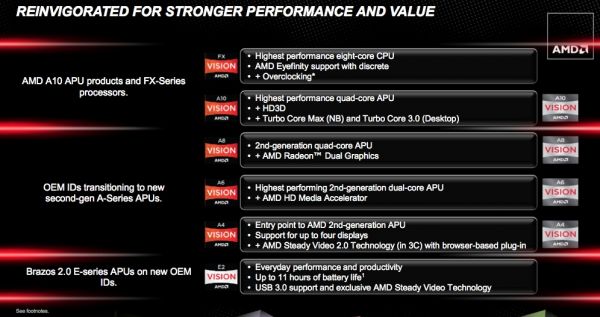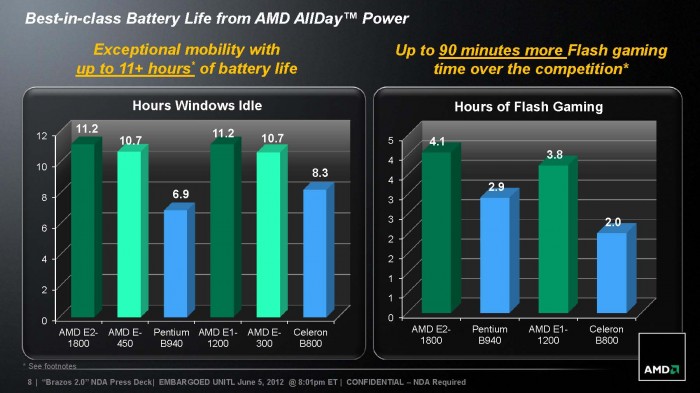A glance over AMD’s plan shows that 2012 will see a greater push for APUs. From high performance systems all the way down to everyday performance and productivity systems, AMD has APUs designed to meet users’ computing needs. After introducing the second generation mobile A-Series APU (codenamed Trinity) in May, AMD today brings us the low power E-Series edition of the APU, codenamed Brazos 2.0, and designed for very basic computing needs.
Unlike the Trinity APUs which had an upgrade on both the CPU and GPU front, Brazos 2.0 uses the same 40 nm “Bobcat” CPU core and the same GPU core as the last generation “Zacate” APU. While the current GPU uses a new model number, HD 7000, it is still architecturally the same GPU as the HD 6000. The new GPU does have an improvement in graphics, gained Steady Video and Quick Stream Technology that will help with smooth video playback.

While the CPU and GPU core on Brazos 2.0 remains the same, the Fusion Controller Hub (FCH) has been updated to support latest generation of hardware. The new APU will come with A68M FCH for mobile SKU or A68 for desktop SKU. Gone are the aging PCI-E 1.0 interface and USB 1.1, replaced with PCI-E 2.0 and USB 3.0 for faster data communication and transfer. The A68 will support three SATA 6 Gbps (two for A68M), two USB 3.0 and 8 USB 2.0, and four lanes of PCI-E 2.0 for GPUs that can CrossFire with the HD 7000, four PCI Express 2.0 lanes for Unified Media Interface (UMI) and an SD card reader support.
AMD apparently is able to reduce the power consumption of the FCH’s idle power by 170 mW which should help out with longer battery life.
| APU Model |
CPU Core
|
# of Cores
|
CPU Clock (Base/Max)
|
L2
Cache (MB)
|
GPU Model
|
GPU Cores
|
GPU Clock (Base/Max)
MHz
|
TDP
|
DDR3
Speeds
|
| A10-5800K |
Piledriver
|
4
|
3.8/4.2 GHz
|
4
|
HD 7660D
|
384
|
800
|
–
|
DDR3-1866
(max)
|
| A10-5700 |
Piledriver
|
4
|
3.44.0 GHz
|
4
|
HD 7660D
|
384
|
760
|
–
|
DDR3-1866
(max)
|
| A8-5600K |
Piledriver
|
4
|
3.6/3.9 GHz
|
4
|
HD 7560D
|
256
|
760
|
–
|
DDR3-1866
(max)
|
| A8-5500 |
Piledriver
|
4
|
3.2/3.7 GHz
|
4
|
HD 7560D
|
256
|
760
|
–
|
DDR3-1866
(max)
|
| A10-4600M |
Piledriver
|
4
|
2.3/3.2 GHz
|
4
|
HD 7600G
|
384
|
497/686
|
35 W
|
DDR3-1600
DDR3L-1600
DDRU-1333
|
| A8-4500M |
Piledriver
|
4
|
1.9/2.8 GHz
|
4
|
HD 7640G
|
256
|
497/655
|
35 W
|
DDR3-1600
DDR3L-1600
DDRU-1333
|
| A6-4400M |
Piledriver
|
2
|
2.7/3. 2GHz
|
1
|
HD 7520G
|
192
|
497/686
|
35 W
|
DDR3-1600
DDR3L-1600
DDRU-1333
|
| A10-4655M |
Piledriver
|
4
|
2.0/2.8 GHz
|
4
|
HD 7620G
|
384
|
360/497
|
25 W
|
DDR3-1600
DDR3L-1600
DDRU-1333
|
| A6-4455M |
Piledriver
|
2
|
2.1/2.6 GHz
|
2
|
HD 7500G
|
256
|
327/424
|
17 W
|
DDR3-1600
DDR3L-1600
DDRU-1333
|
| E2-1800 |
Bobcat
|
2
|
1.7 GHz
|
1
|
HD 7340
|
80
|
523/680
|
18 W
|
DDR3-1333
DDR3L-1066 DDR3U-1066
|
| E1-1200 |
Bobcat
|
2
|
1.4 GHz
|
1
|
HD 7310
|
80
|
500
|
18 W
|
DDR3-1333
DDR3L-1066 DDR3U-1066
|
The E2-1800 and E1-1200 have two CPU cores and come with only 1 MB of L2 cache and supports DDR3-1066, DDR3L-1066, and DDR3U-1066. The E2-1800 runs at 1.7 GHz with the HD 7340 GPU clocked at 523 MHz base and 680 MHz Turbo. The slowest APU, the E1-1200, runs at 1.4 GHz with the HD 7310 GPU running at 500Mhz. The CPU and GPU do get a slight speed bump but they will produce as a dramatic performance increase as what we have seen with the Trinity.
Previously, the fastest Brazos was the E-450 with clockspeed at 1.65 GHz, so the speed bump for the E2-1800 is very marginal. The E2-1800’s HD 7340 GPU speed of 523MHz base and 680 MHz Turbo is a slight bump from the 508 MHz base and 600 MHz Turbo found on the E-450. Again, while the speed bump will have some performance enhancement, it would not mean that you suddenly can play games at 1080p.
The Brazos was the first APU from AMD that is designed to compete against Intel Atom processor. However, the two models that AMD released today is aimed directly against some of the current generation Intel entry level processor. Specially, AMD is positioning the E2-1800 in direct competition against the current generation Intel Pentium processors (17W and 35W) that includes the Sandy Bridge. The E1-1200 is positioned to compete against the Intel Celeron CPUs.
According to AMD, the E1-1200 can deliver up to 11 hours of Windows idle-state battery life and up to 90 minutes more web browsing time with 62.5 W-hr battery pack. However, this number is comparing the 18W E2-1800 against the 35W Pentium B940 that AMD is targeting the APU against.
While we do not have a system to test this, we expect Intel Pentium (especially the Sandy Bridge variant) to be faster than the E2-1800 in the CPU performance. The GPU performance on Brazos 2.0 should be competitive against the Sandy Bridge Pentium processors’ HD 2000. However, AMD’s GPU supports DirectX 11, Shader 5.0, and OpenCL 1.1 while the Sandy Bridge HD 2000 only supports DirectX 10.1, Shader 4.1, and no OpenCL support.
AMD expects OEM manufacturers such as Acer, Asus, HP, Lenovo, Samsung, Sony, and Toshiba to offer systems with the E-Series APU. The Brazos 2.0 APU is expected to be inside systems the sub-$600 laptops and maybe nettops.
 Bjorn3D.com Bjorn3d.com – Satisfying Your Daily Tech Cravings Since 1996
Bjorn3D.com Bjorn3d.com – Satisfying Your Daily Tech Cravings Since 1996













